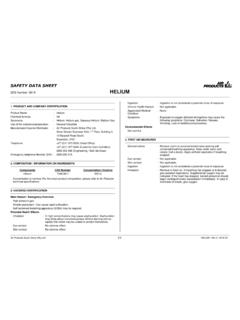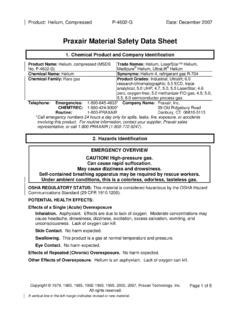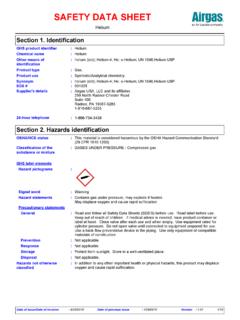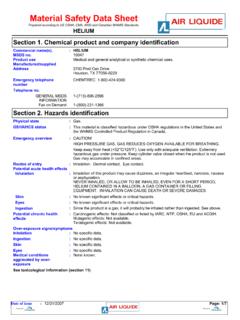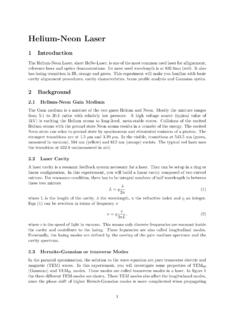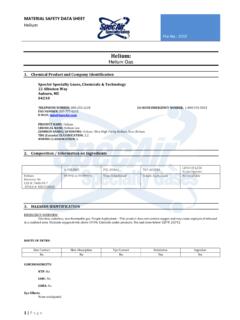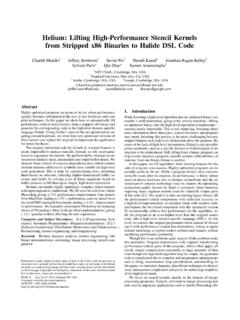Transcription of Helium: A market update
1 Will be lost sometime during the 2020-2025 period. There are also factors that encourage the development of new North American capacity. With the US still the world s largest helium market , domestic supply in decline, and much of the new supply coming from countries that could be subject to political risk, there is significant incentive to develop new US or Canadian supply. Some of the noteworthy recent developments include the following: Air Products commenced production from its new Doe Canyon plant located in Colorado, US earlier this year. This plant is expected to produce 230 million scf per year of bulk liquid helium extracted from a stream of carbon dioxide (CO2) that is utilised for enhanced oil recovery (EOR). This is a first-ever example of helium extraction from a stream of naturally occurring CO2. RasGas has announced that Air Products will supply the helium plant and purchase all of the liquid helium output from the Qatar III plant that is expected to produce 425 million scf per year commencing in 2018.
2 After missing out on direct participation in both Qatar I and Qatar II, Air Products more aggressive approach resulted in an important win at Qatar III. APMTG helium LLC s Big Piney, Wyoming, project remains on hold due to problems with Denbury Resources natural gas processing plant that will be providing the feedgas for the helium plant. The Big Piney Plant is expected to produce 200 million scf per year of liquid helium that will be shared between Air Products and the MATHESON subsidiary of Taiyo Nippon Sanso (TNSC). The latest estimate is that helium production may restart in mid-2016. Praxair has announced a tolling agreement with Castleton Commodities International (CCI) which includes plans to restart CCI s 160 million scf per year Moab, Utah helium refining facility which has been idle for several years As has typically been the case, the helium business continues to be one of the more interesting sectors of the industrial gas business.
3 Whether it is due to interesting applications like MRI or optical fibre manufacturing, sourcing projects in far flung parts of the world, sharp swings from shortage to over-supply or the influence of politics in the US, it seems like there is always a lot going on in the helium world and 2015 has been no this article, I will focus on four aspects of the helium business that I think have been particularly interesting this year: helium market conditions; new source development; the recent US Bureau of Land Management s (BLM) crude helium auction; and the increased interest in developing small fields of previously uneconomic helium -bearing market conditionsAfter three years of severe shortage during the 2011-2013 period ( helium Shortage ), global helium markets are now well into their second year of significant over-supply. By now, almost everyone who has any connection to the helium business is familiar with the basic story; the grinding shortage was caused by curtailed production of helium from the helium refining facilities tied to the BLM Pipeline, that were subject to the allocation of crude helium deliveries by the BLM for an extended period, as well as a series of significant outages at other sources and the delayed start-up of new shortage finally came to an end early in 2014 when new supply came into the market from several sources, most notably the Qatar II plant, which added roughly billion scf (standard cubic feet) to global supply, an expansion of the Skikda, Algeria source and a new Gazprom liquefier in Orenburg, Russia (pictured).
4 Shortage quickly turned to over-supply due to the roughly 25% increment to world capacity, demand destruction that took place during the shortage period, sluggish post-shortage demand for helium , and a relative lack of major maintenance outages throughout the industry in 2014 and magnitude of demand destruction seemed to catch many industry participants by surprise as the prevailing view was that demand for helium would quickly recover when the shortage abated. However, that was not the case, as the three-year period of scarce supply and the sharply higher prices that resulted drove helium users to become more efficient in their helium consumption, to substitute other gases for helium (where feasible), and to invest in recycling. Some sectors of the market , such as the packaged gas segment in the US, may have lost as much as much 20% of demand and demand destruction at the global level may have been as high as 10%.
5 Demand growth coming out of the shortage has also disappointed industry participants, as the dearth of significant new helium applications, combined with sluggish manufacturing growth around the world and residual conservation momentum have made it difficult to find growth in the suppliers have struggled to deal with the excess supply, as most helium is purchased at the source under Take-or-Pay contracts which require the buyer to pay for the helium even if they are unable to take delivery. Given the inability to store very large quantities of helium in purified form, these Take-or-Pay obligations have put some helium suppliers under extreme duress. Not surprisingly, after several years of sharp price increases during the shortage, helium prices have begun to moderate, especially in those markets that are most easily supplied by helium from big question on many market SPECIAL FEATURESPECIAL FEATURE38 | gasworld January 2016 January 2016 gasworld | 39 helium : A market updateBy Phil Kornbluthparticipants minds is when will helium supply and demand come back into balance, bringing the period of oversupply to an end?
6 Answering this question requires careful consideration of a number of factors and assumptions. At what rate will helium demand grow? How quickly will capacity tied to the BLM Pipeline decline due to depletion of the US Federal Reserve? Will there be any significant plant outages? When will new sources enter the market ? What steps will the helium Refiners (Air Products, Linde, Praxair and Badger Midstream) or other suppliers take to curtail production?The author s view is that the industry is going to continue to experience over-supply at least through much of 2016, or roughly another year. I do not foresee a near term spike in demand or any new applications that are significant enough to move the needle for global demand. However, there are some encouraging signs on the production side of the equation, as helium refiners have actually shutdown some of their production to temporarily remove supply from the market , and one or more of the major suppliers have taken the unprecedented and radical step of importing bulk liquid helium into the US from Qatar and injecting it into the BLM Pipeline and Storage System for future use.
7 While doing this would be very costly, it is a better alternative than paying Take-or-Pay penalties and would temporarily remove supply from the encouraging sign is that ExxonMobil, who operates the world s largest helium plant in Shute Creek, Wyoming (US), has informed its customers that it will be taking a significant maintenance outage during the July-September 2016 period. The lack of scheduled maintenance outages at ExxonMobil s plant in both 2014 and 2015, which was heretofore an annual event, has exacerbated the only modest new capacity expected to enter the market before Qatar III in 2018, these actions and events may curtail supply sufficiently to bring helium markets back into a more balanced state by late 2016. But the author would like to remind the readers of this article that his experience over 33 years in the helium business has taught him that forecasting future market conditions tends to be a very humbling experience.
8 New source developmentsDespite the current over-supply in the market , and the fact that some market participants have had a great deal of difficulty coping with their Take-or-Pay commitments, there continues to be a lot of interest in the development of new sources. There are several factors that could explain what might appear to be irrational behaviour at first helium refiners, who still have significant capacity dependent on the operation of the BLM Pipeline and Storage System could be taking a long-term view to the time when crude helium from the Federal Reserve will only be available for supply to US government users. The refiners need to replace the portion of their current capacity that GazpromSPECIAL FEATUREJ anuary 2016 gasworld | | gasworld January 2016due to a lack of feedgas. It is believed that Praxair will be taking delivery of most or all of the liquid helium output from this plant.
9 The feedgas for the plant will be coming from nearby fields that are extracting helium from helium -bearing natural gas fields that were not economically viable until helium prices increased during the 2011-2013 shortage. Most of the crude helium feedgas for the Moab Plant will be transported to the plant via tube trailer. helium production from the Moab Plant is expected to commence in 2016. QEP Resources has gone public with plans to develop a 700 million scf per year helium plant in the Dry Piney Creek area located in southwestern Wyoming. While QEP Resources is preliminarily targeting a third quarter (Q3) 2019 start-up, there is speculation that the timing of this project could be delayed due to lead time required to obtain environmental approvals as well as the impact of low oil prices, which could affect the demand for CO2 (used for EOR) produced by this project.
10 Last, but certainly not least, is Gazprom s huge project to produce helium at the Amur Natural Gas Processing Plant which is under construction in the Amur Region of Siberia, relatively close to the Russian border with China. This project is an offshoot of the well-publicised agreement between Russia and China, where Russia will supply huge quantities of natural gas from the Chyanda and Kovykta fields under a 30-year agreement with China. helium production is expected to commence by early 2021, with capacity increasing in stages to billion scf per year, eventually making this the world s largest source of helium . Potential helium production from this project could reach as high as billion scf per year. However, unless the world s demand for helium increases dramatically from current levels, it is hard to conceive that helium production from the Amur facility will ever approach that level and more likely that much of the helium extracted from this gas will be reinjected into the natural gas fields, or a dedicated underground storage facility, and stored for the future.
